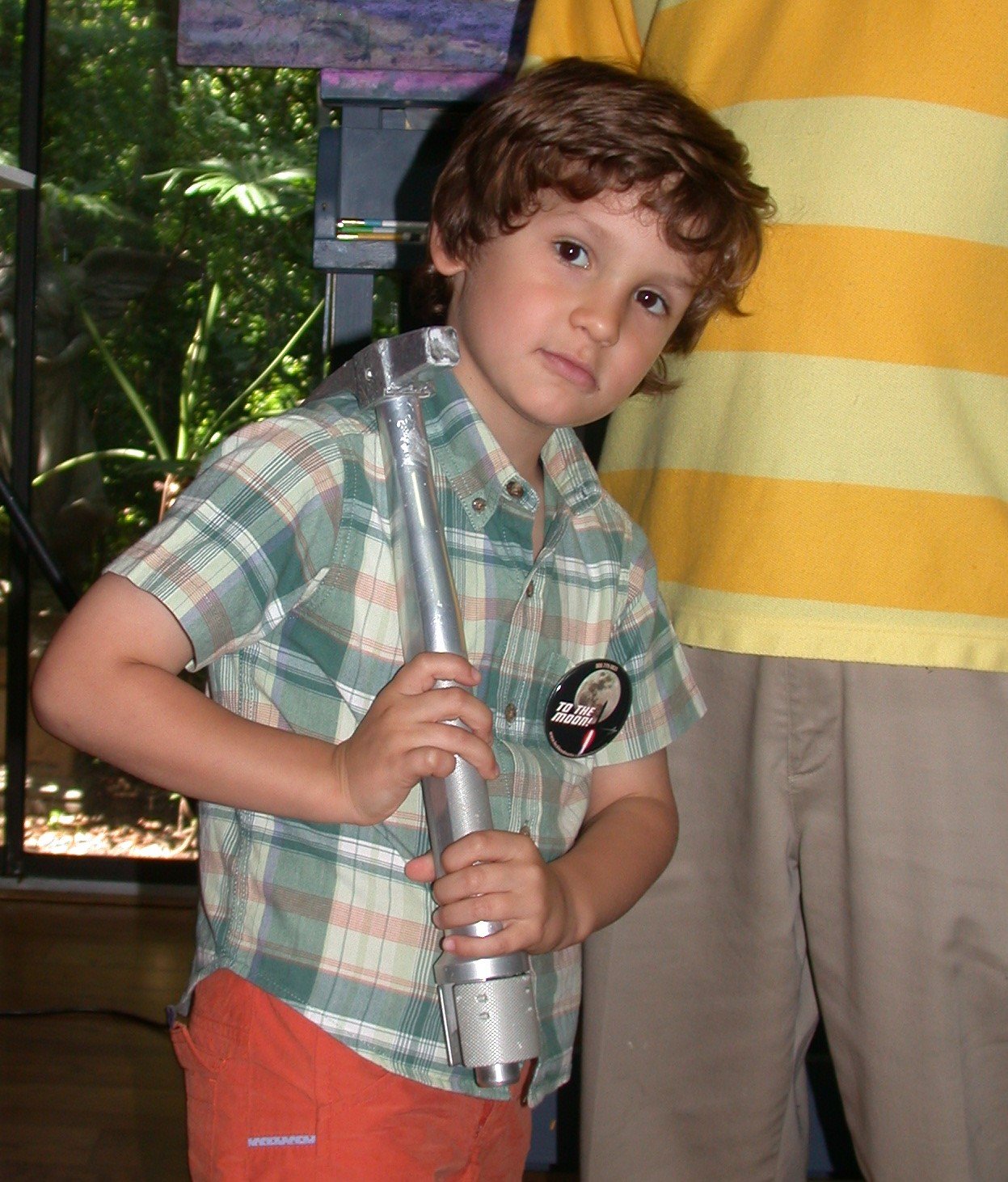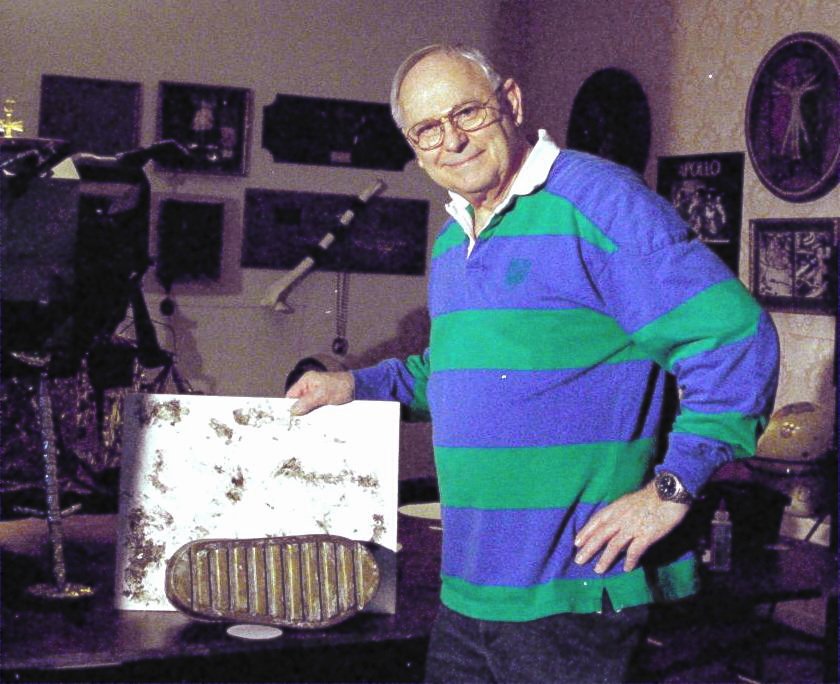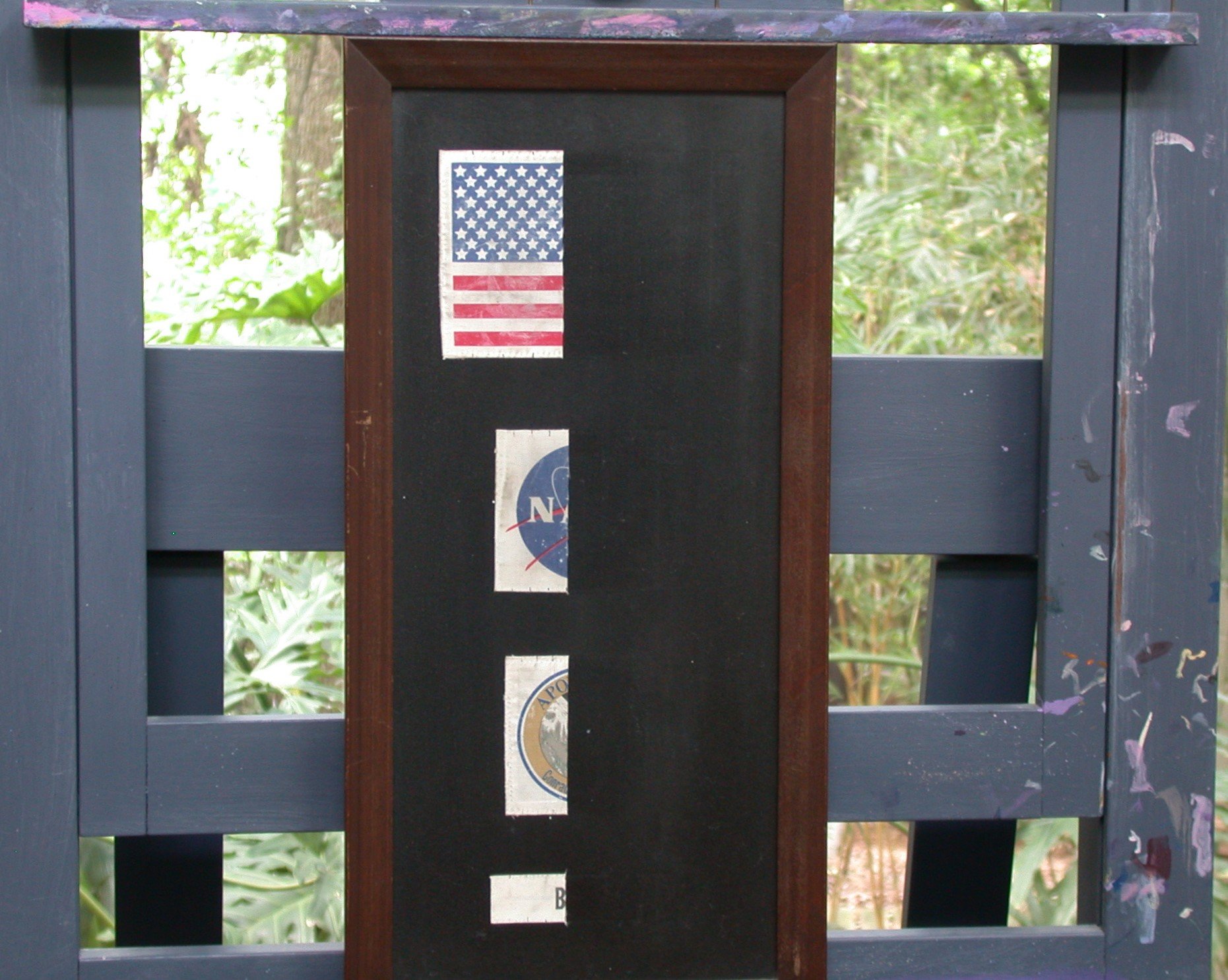Alan Bean (1932-2018) -
Artist and Moonwalker
by Ulrich Lotzmann
2002 portrait of Alan Bean superimposed on one of his paintings
I have seen many places in the USA that are related to the Apollo moon landing program and I have visited many space museums that display flown Apollo hardware; but nowhere else have I felt the spirit of Apollo more strongly and more vividly than in Alan Bean's studio, surrounded by his impressive and inspiring paintings. Each is an eyewitness account of the first human explorations of another celestial body. They are really art 'off this world'.
Panoramic view of Alans studio in 2008
Alan Bean, born on the 15th of March 1932 in Texas, was a trained U. S. naval aviator and test pilot when he was selected in 1963 for NASA's third astronaut group. In 1969 he made his first space flight. As the Lunar Module Pilot of Apollo 12, he became the fourth man in history to walk on the lunar surface, preceded only by Neil Armstrong, Buzz Aldrin and Pete Conrad.
Pete Conrad (left), Dick Gordon (center) and
Al Bean (right), the Apollo 12 crew, pose in
front of their Saturn V.
On Nov. 19, 1969, Alan Bean climbs down the ladder of the Lunar Module to become the 4th human to walk on the Moon.
In 1973 Bean made his second space flight - this time as Commander of the second Skylab crew that spent a record-breaking 59 days in Earth orbit.
Skylab. America’s first space station, in Earth orbit
Alan Bean during a Skylab EVA
Alan's 1961 painting Three Women
Often Alan Bean is described as an artist who flew to the Moon, but that's a stereotypical idea. He walked on the Moon and later flew aboard Skylab as a highly trained astronaut who was completely focused on the success of his mission: no time for sketches, no time for little paintings. It would be a couple of years after his Skylab flight before he began to express his own memories and feelings, as well as the memories of his fellow moonwalkers in an artistic manner.
Alan Bean improving his artistry in 1965
Bean's development as a painter began when he took his first art class while he was a test pilot at Patuxent River, Maryland. Among the early works are flower motifs, abstract flight motifs, and copies of paintings by Cezanne, Degas, and Greacen.
After his Apollo 12 and Skylab 3 space flights, he worked on the Space Shuttle program and was named acting Chief Astronaut, overseeing the training of new astronauts. For the first time since he was assigned to Apollo 12, he was no longer preparing for an upcoming flight of his own and, all of sudden, there was spare time for an old love: painting.
In an interview for the Texas Alcalde magazine, Bean described how he decided to start a new career as an artist:
"A friend of mine from the University of Texas, Pat Brill, and I were out having dinner one night when I'd come back from Skylab, and she said to me, 'What are you going to do when you leave NASA and you quit being an astronaut?”I said, “Well, I'm not planning on doing that any time soon, but I'll probably go to work for Rockwell or McDonnell-Douglas or something like that.” And she said, “Well you ought to be an artist.” I said, “You're crazy.”
I hadn't painted any space paintings, only other traditional kinds of paintings. She said, “No, I think you could make a living being an artist.” I had never thought of that as a profession, even though it was my hobby.
After she said that, then I couldn't get it out of my mind. I began to say things like, “You know, it's true. I paint on the weekend. I don't go designing airplanes on the weekend. Maybe I would really like being an artist.”
So I took some time off and painted full-time to see if I'd like it. I simulated it, which is always good. I learned that at NASA; and the more I simulated being an artist, the more I realized it's much more difficult than I'd thought. But at the same time I liked it. I cared about it! I had many nice job offers for a lot of money, but I didn't care about them. I care about these paintings. I care about them every day."
In 1984, only 3 years after Alan Bean left NASA to start his new career as an artist, two exhibitions of his Apollo paintings took place at the Meredith Long Art Gallery in Houston. They were great successes and suddenly people started to realize that Bean's works are really masterpieces of fine art.
Alan Bean's paintings are both impressionistic and technically detailed. They are an attempt to accurately and objectively record the visual reality of stories that he believed future generations will enjoy. Bean preferred to paint his motifs with acrylics, because acrylics are as high tech as his subjects. Although developed in the 19th century, acrylics occurred first on the art scene during the beginning space age and are the most important innovation in artistic materials since the invention of oil paints.
Acrylic paints are made of emulsions of pigments, water, and clear, non-yellowing resins. They dry quickly and without changing color. Acrylics are weather resistant and retain their brilliance with age. Covered with a final coat of varnish there's no need to frame them under glass.
A distinctive characteristic of an original Bean painting is its rough and very specific surface texture. To attain the desired effect, he took a sheet of masonite or aircraft plywood cut to the desired size and covered it with a thick acrylic modelling paste. The following image shows a textured surface prepared for a painting. The item marked '1' is a core-tube bit used to make circular impressions in the acrylic modelling paste. The items labelled '2' are small pieces of the US flag that had been sewn on Alan Bean's lunar suit. The label '3' indicates fragments of foil insulation from the Command Module docking hatch, and label '4' indicates charred material from the Command Module heat shield. Note, also, the bootprint that covers much of the upper righthand quarter of the image.
When the acrylic layer started to set, Bean began to texture its surface. First, he used the sole of a lunar boot replica to impress footprints into the acrylic paste.
Alan Bean with a bronze replica of a lunar boot sole
Bootprint in the surface of a painting
Next, he added additional texture with the geology hammer that he used on the Moon in November 1969 to do such things as plant the US flag on the Ocean of Storms, loosen the fuel element for the ALSEP, attempt to repair the broken TV camera, and drive core tubes deep into the lunar soil. Although the hammer was to have been discarded on the Moon, Alan Bean brought it back to Earth as his very special memento.
With the hammer, he made various marks in the hardening modeling paste. Other, round marks are added by pressing on the paste with one of the core tube bits used on the Moon to penetrate the lunar surface.

Alan hammering a core tube into lunar ground

Little Christian Lotzmann with the Apollo 12 flown geology hammer.

Core bit used on the lunar surface to collect soil samples

Hammer and core bit - tools Alan used to texture the surface of his paintings

(1) circular core bit marks, (2) streaks made with the hammer
To add to the unique character of his paintings, and to give them the very personal touch of a man fortunate to have walked on the Moon, he cut small pieces from the U.S. flag or from his name tag or the NASA and Apollo 12 mission patches that were sewn on his space suit and backpack and fixed them on the textured surface, using a thin acrylic medium. Because Bean and Conrad spent more than seven hours outside the lunar module and got their suits very dirty as they worked, each of the fragments is impregnated with small amounts of lunar dust. As a final touch, Bean added small pieces from the gold Kapton foil that insulated the command module Yankee Clipper's hatch leading to the lunar module Intrepid. He also added charred particles from Yankee Clipper's heat shield. Thus the base layer of all of his paintings contain small pieces of his space suit and the command module and also very small amounts of Moon dust. Finally, the paintings, themselves, convey unique memories of an unique era.
Detail of Alan Bean's suit with the US flag and the Apollo 12 mission patch. Image taken by Pete Conrad during the second moon walk.
After the Apollo 12 mission the original flown patches from his suit were presented to Alan.
Pieces cut from these patches and pieces of the insulation foil from the Command Module were embedded into his paintings.
In his early years as an artist, his paintings were mainly based on photographs and film footage taken during the moonwalks or during astronaut training. Later, he increasingly began to recreate the scenes planned for the paintings in advance using models of the astronauts, the Lunar Module, the Surveyor III probe and the Rover all built in 1/7 scale.
The lunar module and most of the astronaut „figures“ models Alan used as a reference were built or modified by David Senechal.
Alan Bean with his wonderful and detailed LM-6 model built from scratch between 1996 - 1999 by David Senechal.
Photo credit: David Senechal
Alan with his good friend David Senechal in July 1999. David holds one of the astronaut models he has built for Alan. Photo credit: D. Senechal
Alan with model maker Nick Proach and the just delivered 1/7 scale model of the Surveyor III probe. Photo taken in 2002. Photo credit: Nick Proach
The 1/6 scale Rover here used to plan the scenery of the painting “Slip Slidin’ Away” was also built by Nick Proach
Other visuals that helped him execute his paintings included the original Skylab 3 EV gloves, the cuff checklist he wore during his 2 moonwalks, and a pair of original lunar boots.
Alan’s right A7LB EV glove flown on the Skylab 3 mission
Alan’s Cuff Checklist worn during his 2 moonwalks
A pair of original Lunar Boots
The follwing picture shows how the back of a finished Bean painting typically looks like. Besides the background story of the painting placed in the center Alan gives advice how to take “tender lovin’ care” for the painting in particular how to clean it from time to time. A further text provides information about the way he designed the surface of his paintings.
Influenced by the works of French impressionist Claude Monet (1840-1926), who is his favorite painter, Bean has developed his very own style and he was until his death looking for new impressionistic interpretations of his lunar motifs (below). The series of paintings entitled 'Cernan, Gnomon and Crater' provides examples of his search for colors that he can use 'while still making the Moon look like itself'.
Two exhibitions of his artwork were particularly important for his career as an artist:
His first gallery exhibition took place in 1984.
At a preview party at the renowned Meredith Long and Co Galleries in Houston on July 28 1984, eight paintings were shown, although they were not for sale. The preview was an "appetizer" for a larger successful exhibition in November '84.
Alan passed the ultimate test - the audience of skeptics and art critics.
Different versions of Cernan, Gnomon, and Crater (1998)
Alan with his wife Leslie next to his painting
“Too Beautiful To Have Happened by Accident” at a cocktail preview party at the Meredith Long and Co Galleries.
Photo credit: Steve Campbell/Chronicle
Alan at the preview party explaining his “lunar footwork”. Photo credit: Steve Campbell/Chronicle
At the preview event Victoria Elliot who works for The New York Academy of Art in Manhattan as a consultant and the Lisson Gallery in London is admiring Alan’s painting “Big Al’s Rickshaw”. She thought the painting was better than a photograph as it has more depth.
Photo credit: Steve Campbell/Chronicle
In the period from July 16, 2009 to Jan 13, 2010 the largest exhibition of Alan’s ouevre with more than 40 original paintings, drawings and studies was one of highlights at the Air and Space Museum in Washington D.C. According to Alan, this exhibition was only possible thanks to the support of his good friend Tom Kartsotis.
Lajos Markos, a reknown Hungarian-born portrait painter and painter of historical subjects, particularly of the American West, stated shortly before his death in 1993:
"If I could own one painting of Bean or one by another - let's say from Monet or Manet -
I would prefer Alan Bean."
Title of the 2009 exhibition: “ALAN BEAN - PAINTING APOLLO - First Artist on Another World
Alan with his beloved wife Leslie and Tom Kartsotis at the opening event of Alan’s art exhibition at the Air and Space Museum in Washington DC on July 16, 2009.
Photo credit: Tom Kartsotis
Leslie and Alan Bean on July 16, 2009: Proud, happy and thrilled.
The opening of the exhibition took place in conjunction with the celebration of the 40th anniversary of the Apollo11 moon landing.
Butler Medal
On Oct. 14, 2005, Alan Bean was awarded the Butler Institute's Medal for Life Achievement in the Arts. Prior recipients include: artist Robert Rauschenbert; art historian and museum director Tom Hoving; sculptor Louise Nevelson; painter Clarence Carter; painter Jack Levine: art critic and writer David Shirev; and art historian Leo Castelli. The medal has the Butler Institute building on the front and the Institute's signature painting, Winsow Homer's "Snap the Whip" on the back.
Farewell Dear Friend
Through our Apollo connection, Alan brought us into the world of art, and we will always have him to thank for that. We are grateful for his friendship and the opportunity to learn from him. Over the last 37 years, he created wonderful paintings comprising a unique, eyewitness account of mankind's greatest adventure. Now, there is only one work left on the easel, Alan's unfinished effort to paint the most beautiful impressionistic Earth ever done.
Rest in Peace, Alan
Andy, Eric, Ken, Michael, and Ulli
Alan’s interment services took place on Nov 8, 2018 at Arlington National Cemetery, Virginia
The Astronaut Memorial Grove at Johnson Space Center during the holiday season in 2023. In April 2019 a tree dedication ceremony was held in honor of Alan. Thanks to Leslie and Mark Geyer, director of JSC, Alan’s tree is illuminated during the holidays in vibrant colors - symbolizing his artistic side. Photo credit: Leslie Bean

































